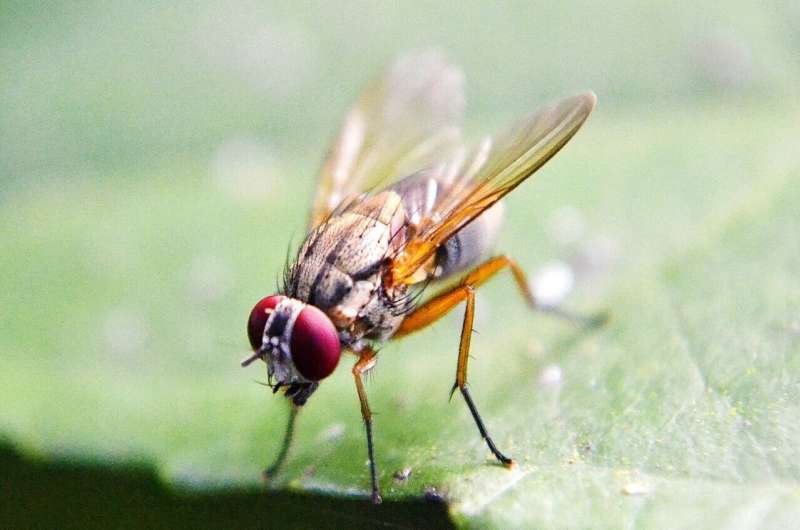This article has been reviewed according to Science X's editorial process and policies. Editors have highlighted the following attributes while ensuring the content's credibility:
fact-checked
peer-reviewed publication
trusted source
proofread
Fighting fruit flies help researchers understand why we stay angry

It's one of those days. On the drive home from work, the car in the next lane cuts you off. You slam on the brakes, lay on the horn, and yell choice words at the offending driver. When you walk into your house half an hour later, you're still angry and snap at your partner when they ask about your day.
Fruit flies may not have to worry about the lingering effects of road rage, but they also experience states of persistent aggression. In the case of female fruit flies, this behavior is a survival mechanism, causing the flies to headbutt, shove, and fence other female fruit flies to guard prime egg-laying territory on a ripe banana.
Now, researchers at Janelia and the California Institute of Technology are homing in on the neurons, circuits, and mechanisms responsible for this tenacious behavior.
In a new study in eLife, the researchers report they've teased out the cell types contributing to a persistent aggressive state in female fruit flies, showing that some cells associated with aggression can cause flies to remain angry for up to 10 minutes.
They also found that this persistent state may not be solely due to a recurrent connection between the aggression-associated cells, as had been thought. In a recurrent connection, signals loop back and feed into the same neural circuit, which could cause a behavior to persist.
Instead, the new research suggests persistent aggression could be regulated by other factors, including neuromodulators affecting neuronal activity, neurons downstream from the aggression-associated cells, or other circuits in the fly brain. Considering their findings, scientists may need to develop a new model that considers these other factors in addition to recurrent connections to explain this enduring behavior.
"It is interesting for the field because we talk about these recurrent connections as being key for the persistent state, and that's really what we thought," says Katie Schretter, a postdoc in the Rubin Lab who led the research. "But now it seems less clear in this case."
Understanding persistent internal states like aggression could help researchers better uncover how the brain makes decisions—for instance, whether to stay mad or move on—and the individual circuits involved in these choices. Figuring out the underlying mechanisms behind aggression could also help scientists better understand aggressive behavior in humans, including behaviors that can occur alongside neurodegenerative or psychiatric diseases.
"For our society, it's important to be able to decrease aggression and figure out how to stop persistent aggression," Schretter says. "Figuring out how the circuit works can help us figure out how we might decrease it."
Fighting fruit flies
Scientists had previously identified cell types associated with aggression in the brains of female fruit flies. They found that activating these cells caused the flies to fight. Given this, the team, led by Schretter, Cal Tech graduate student Hui (Vivian) Chiu, Janelia Senior Group Leader Gerry Rubin, and HHMI Investigator David Anderson, wanted to look at these cells to see how their signals might feed back into each other to generate a persistent aggressive state.
The researchers separated female flies with a barrier and then activated the different cell types associated with aggression for 30 seconds at a time. They kept the flies separated for specific periods of time, up to 30 minutes, before removing the barrier and letting them interact.
The team hypothesized that recurrent connections between certain aggression-associated cell types could cause the flies to remain aggressive for longer periods of time.
They found that one cell type associated with aggression—aIPg—contributes to persistent aggression. When these cells were activated, the flies would fight for up to 10 minutes after removing the barrier. However, another cell type previously found to be involved in aggression—pC1d—did not cause this same enduring anger.
pC1d also didn't affect whether aIPg caused persistent aggression, and neither pC1d nor aIPg showed persistent neuronal activity. These findings suggest that a persistent aggressive state doesn't depend on a recurrent connection between the two cell types.
Previous research had shown that stimulating another cell associated with aggression—pC1e—also does not cause persistent behavior on its own. However, Schretter and colleagues were surprised to find that when pC1d and pC1e were stimulated simultaneously, the flies remained persistently aggressive.
Taken together, the results suggest that the persistent aggressive state may be maintained by a mechanism different from what the researchers had originally thought. Instead of being due to a recurrent connection between aIPg and pC1d, as they had hypothesized, persistent aggression could involve pC1e. But it could also include other factors, such as a neuromodulator acting on the circuit or the effect of neurons downstream from aIPg, pC1d, and pC1e. Or aggression could be controlled by another circuit altogether.
Schretter says investigating these other models to explain persistent aggression is the next step.
"It's exciting to see what else could lengthen that persistence, because there could be other circuits that are also involved," she says. "It is basically open for us to go after, so it is a fun place to be."
More information: Hui Chiu et al, Cell type-specific contributions to a persistent aggressive internal state in female Drosophila, eLife (2023). DOI: 10.7554/eLife.88598.1





















